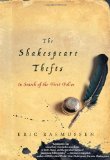
October 30, 2011, by Peter Kirwan
Hunting Folios: Eric Rasmussen’s “The Shakespeare Thefts”
- Title:
- The Shakespeare Thefts: In Search of the First Folios
- Author:
- Eric Rasmussen
- ISBN:
- 0230109411
- Rating:
- Not rated
One of the relatively unknown problems in scholarly research is – what do you do with the stories? Inevitably, as we research, we turn up anecdotes, gossip, juicy titbits which are simply inappropriate to go in the monograph or article. Some of us (and I’m very guilty of this) relegate them to footnotes. Others pop them in TLS letters or Guardian articles. Some don’t publish at all, but save them for conference dinner conversation. Particularly in Shakespeare studies, there are so many eccentrics and fascinating narratives that it’s a shame for them to be lost.
That, at least, is the rationale behind The Shakespeare Thefts by Eric Rasmussen, scholar and bibliophile (and one of my general editors on the Collaborative Plays project. For over a decade, Rasmussen has been leading one of the most ambitious bibliographic enterprises ever mounted, the physical cataloguing of every extant copy of the 1623 First Folio. The results came out this year in The Shakespeare First Folios: A Descriptive Catalogue, co-edited with Anthony James West. This mammoth reference resource describes the folios in painstaking detail, from watermarks and scuffs to frayed edges, to more obviously interesting idiosyncracies such as marginalia, pasted pages and pawprints (!). At £225, however, it’s not for the casual reader, and while the bibliographic detail will be of lasting value to book scholars, it’s not information that will attract a wide audience. Thus, The Shakespeare Thefts.
This short book, arranged as an eclectic series of anecdotes, reminiscence, stand-alone narratives and detective stories, rounds up the juicier side of the team’s research in compiling the larger volume. The unique cultural value accorded to the First Folio has made it a prime target for thieves, bootleggers, eccentric collectors and forgers.In tracing the provenance and history of the books, Rasmussen’s team also compiled the more interesting instances of Folio theft and reappropriation, which make up the book.
Rasmussen’s style is personal and humorous, often veering into personal anecdote: Rasmussen’s son refers to his personal copy of the Second Folio as his "college fund", and a whole chapter is devoted to Rasmussen’s purchase of a fakr portrait of Shakespeare and the ensuing TV journalism debacle. What comes across most strikingly is the personal enthusiasm for book history and the comic self-awareness of the extremes of obsession, not least in describing one team member’s jubilant reaction to the discovery of a hair in an original Folio, and the complete lack of enthusiasm for the discovery on the part of the book’s librarian.
That this is a labour of love is always apparent. Rasmussen’s team of Folio hunters (who all get their moment to shine, and develop their own "characters" at various points in the book) travel the Globe to barter with Japanese private collectors, take tea with English earls and fight with librarians. One gets a sense of the scale of the enterprise, and of its importance, in Rasmussen’s repeated return to his frustration with one Japanese family that continues to deny him access to view its prized copies. It’s become, as in the title of one chapter, "Obsession"; yet it’s an obsession driven by the scrupulousness of the team’s scholarship and their wish to make the information available for future generations.
Of course, one of the most important effects of this kind of detailed study is that theft and resale becomes almost impossible, as each Folio is now so individually identifiable. The cornerstones of this book are the extended stories of particularly notable incidents, including Raymond Rickett Scott’s well-documented attempt to pass on the Durham University copy, the deliberate theft of a Folio by William John Kwiatkowski (eventually revealed when an accomplice panicked that the Folio would end up in Hitler’s possession) and the Folio once owned by Charles I. That thefts involve extraordinary pre-planning and ingenious attempts to disguise the books through mutilation gives the stories their meat; however, Rasmussen offers an interestingly mixed response to the individualisation of Folios. He loves ephemera and hand-annotation, and is even supportive of the expert facsimile pages created by John Harris to piece out incomplete volumes. Yet on the other hand, the deliberate desecration of Folios by would-be thieves becomes the mutilation of national treasures. It’s a fascinating story, and one becomes aware of the fragility of these precious artefacts, yet eager to get them into one’s own hands and feel the connection to the past.
The skill of Rasmussen’s writing is in getting the reader excited about old books, offering colourful stories that turn paper and ink into individuals with living histories and murky pasts. It’s a wonderful record of a passion project, and the ideal companion to the bibliographic volume.
No comments yet, fill out a comment to be the first

Leave a Reply